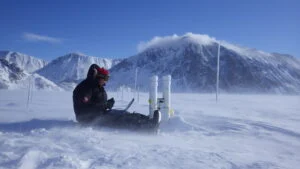
People & Culture
On thin ice: Who “owns” the Arctic?
As the climate heats up, so do talks over land ownership in the Arctic. What does Canadian Arctic Sovereignty look like as the ice melts?
- 4353 words
- 18 minutes
This article is over 5 years old and may contain outdated information.
Science & Tech

Could modern airships — descendants of craft like the US Navy’s massive “Snow Goose,” which startled Inuit as it floated over their camps on its 1958 voyage to the High Arctic — represent the future of transport in the Arctic? Absolutely, says Barry Prentice, a University of Manitoba transport economist. While the Hindenburg disaster, the Second World War, and the jet engine all helped end the era of the airship, conditions are now primed for its return as a viable means of transport — particularly in the North.
“When the jet engine was first developed, fuel was cheap, speed was important and no one cared about emissions or the environment,” Prentice points out. “Today, all those things have changed. The environment is important, fuel is expensive and freight doesn’t require speed. Shipping freight by jet at 500 miles per hour is a waste.”
Indeed, Prentice says, the modern helium airships currently in development will be able to transport cargo at about a quarter of the cost of fixed-wing aircraft, while generating a fraction of the harmful emissions. And nowhere do economic and environmental conditions favour a return to airship transport more than in the Canadian Arctic.
“The ice roads are failing, flying cargo north in airplanes is horribly expensive and the cost of building all-weather roads is horrendous,” notes Prentice. And, unlike cargo ships, airships could operate in the Arctic year-round. Prentice predicts that, with global warming, stricter emissions regulations, and the likelihood of continued high energy prices, the first commercial cargo airships will begin flying within two years, and will be servicing northern transport needs shortly thereafter.
“We absolutely have to have a solution for the North, and sooner or later we’re going to come around to the airship because it’s the one that makes the most sense,” says Prentice. The “Snow Goose’s” descendants, far from startling Inuit, may soon be helping alleviate high costs in their communities.


Are you passionate about Canadian geography?
You can support Canadian Geographic in 3 ways:

People & Culture
As the climate heats up, so do talks over land ownership in the Arctic. What does Canadian Arctic Sovereignty look like as the ice melts?

Environment
The uncertainty and change that's currently disrupting the region dominated the annual meeting's agenda

People & Culture
Award recipients honoured in the first virtual Annual General Meeting and Fellows Show.

Science & Tech
Celebrating Canadian Innovation Week 2023 by spotlighting the people and organizations designing a better future